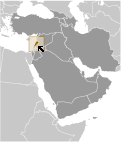World Atlas: Lebanon. On this page you can see the map, country flag and many detailed information about the people, history and economy of Lebanon.

Here you can find online selected information about the geography, inhabitants, government, economy and history of Lebanon. Included are selected statistics, an overview map and the detailed map of Lebanon. But let's start with the flag of Lebanon here:
Lebanon - Overview:
What you should know about Lebanon? Let's start with this: Following World War I, France acquired a mandate over the northern portion of the former Ottoman Empire province of Syria. The French demarcated the region of Lebanon in 1920 and granted this area independence in 1943. Since independence the country has been marked by periods of political turmoil interspersed with prosperity built on its position as a regional center for finance and trade. The country's 1975-90 civil war that resulted in an estimated 120,000 fatalities, was followed by years of social and political instability. Sectarianism is a key element of Lebanese political life. Neighboring Syria has historically influenced Lebanon's foreign policy and internal policies, and its military occupied Lebanon from 1976 until 2005. The Lebanon-based Hizballah militia and Israel continued attacks and counterattacks against each other after Syria's withdrawal, and fought a brief war in 2006. Lebanon's borders with Syria and Israel remain unresolved.
Geography of Lebanon
 Where on the globe is Lebanon? The location of this country is Middle East, bordering the Mediterranean Sea, between Israel and Syria. Total area of Lebanon is 10,400 sq km, of which 10,230 sq km is land. So this is quite a small country. How could we describe the terrain of the country? This way: narrow coastal plain; El Beqaa (Bekaa Valley) separates Lebanon and Anti-Lebanon Mountains. The lowest point of Lebanon is Mediterranean Sea 0 m, the highest point Qornet es Saouda 3,088 m. And the climate is Mediterranean; mild to cool, wet winters with hot, dry summers; the Lebanon Mountains experience heavy winter snows.
Where on the globe is Lebanon? The location of this country is Middle East, bordering the Mediterranean Sea, between Israel and Syria. Total area of Lebanon is 10,400 sq km, of which 10,230 sq km is land. So this is quite a small country. How could we describe the terrain of the country? This way: narrow coastal plain; El Beqaa (Bekaa Valley) separates Lebanon and Anti-Lebanon Mountains. The lowest point of Lebanon is Mediterranean Sea 0 m, the highest point Qornet es Saouda 3,088 m. And the climate is Mediterranean; mild to cool, wet winters with hot, dry summers; the Lebanon Mountains experience heavy winter snows.
Inhabitants of Lebanon
Let's take a look how many people live in Lebanon. The number is: 6,229,794 (July 2017 est.). So this is not very populous country. Who lives here? Arab 95%, Armenian 4%, other 1%. What are the languages in Lebanon? Arabic (official), French, English, Armenian. And the religions: Muslim 54% (27% Sunni, 27% Shia), Christian 40.5% (includes 21% Maronite Catholic, 8% Greek Orthodox, 5% Greek Catholic, 6.5% other Christian), Druze 5.6%, very small numbers of Jews, Baha'is, Buddhists, Hindus, and Mormons. How old are the people in average? 30.5 years. We have to add that this number is the median - so one half of the people is older than this, one half is younger. And what is their life expectancy (at birth)? This: 77.8 years. Where the people live in Lebanon? Here: the majority of the people live on or near the Mediterranean coast, and of these most live in and around the capital, Beirut; favorable growing conditions in the Bekaa Valley, on the southeastern side of the Lebanon Mountains, have attracted farmers and thus the area exhibits a smaller population density. The major urban areas of Lebanon are: Beirut (capital) 2.226 million (2015).
Government and Economy of Lebanon
The capital of Lebanon is Beirut and the government type parliamentary republic. Let's take a look at the administrative divisions - 8 governorates (mohafazat, singular - mohafazah); Aakkar, Baalbek-Hermel, Beqaa (Bekaa), Beyrouth (Beirut), Liban-Nord (North Lebanon), Liban-Sud (South Lebanon), Mont-Liban (Mount Lebanon), Nabatiye. Regarding the economy of Lebanon, important industrial products are banking, tourism, food processing, wine, jewelry, cement, textiles, mineral and chemical products, wood and furniture products, oil refining, metal fabricating. Important agricultural products are citrus, grapes, tomatoes, apples, vegetables, potatoes, olives, tobacco; sheep, goats. The most important export commodities are jewelry, base metals, chemicals, consumer goods, fruit and vegetables, tobacco, construction minerals, electric power machinery and switchgear, textile fibers, pape and the most important export partners are South Africa 21.1%, Saudi Arabia 9%, UAE 8%, Syria 6.7%, Iraq 5.4% (2016). The most important import commodities are petroleum products, cars, medicinal products, clothing, meat and live animals, consumer goods, paper, textile fabrics, tobacco, electrical machinery and equipment, chemicals and the most important import partners are China 11.2%, Italy 7.5%, US 6.3%, Germany 6.2%, Greece 5.7%, Egypt 4.1% (2016). How rich is Lebanon and how rich are people in this country? The most important number here is GDP per capita (PPP): $19,500 (2017 est.). This is quite good. Let's add that this means Gross Domestic Product per person, which is recalculated with respect to the relative cost of local goods and services. And one more important number - population below poverty line: 28.6% (2004 est.).